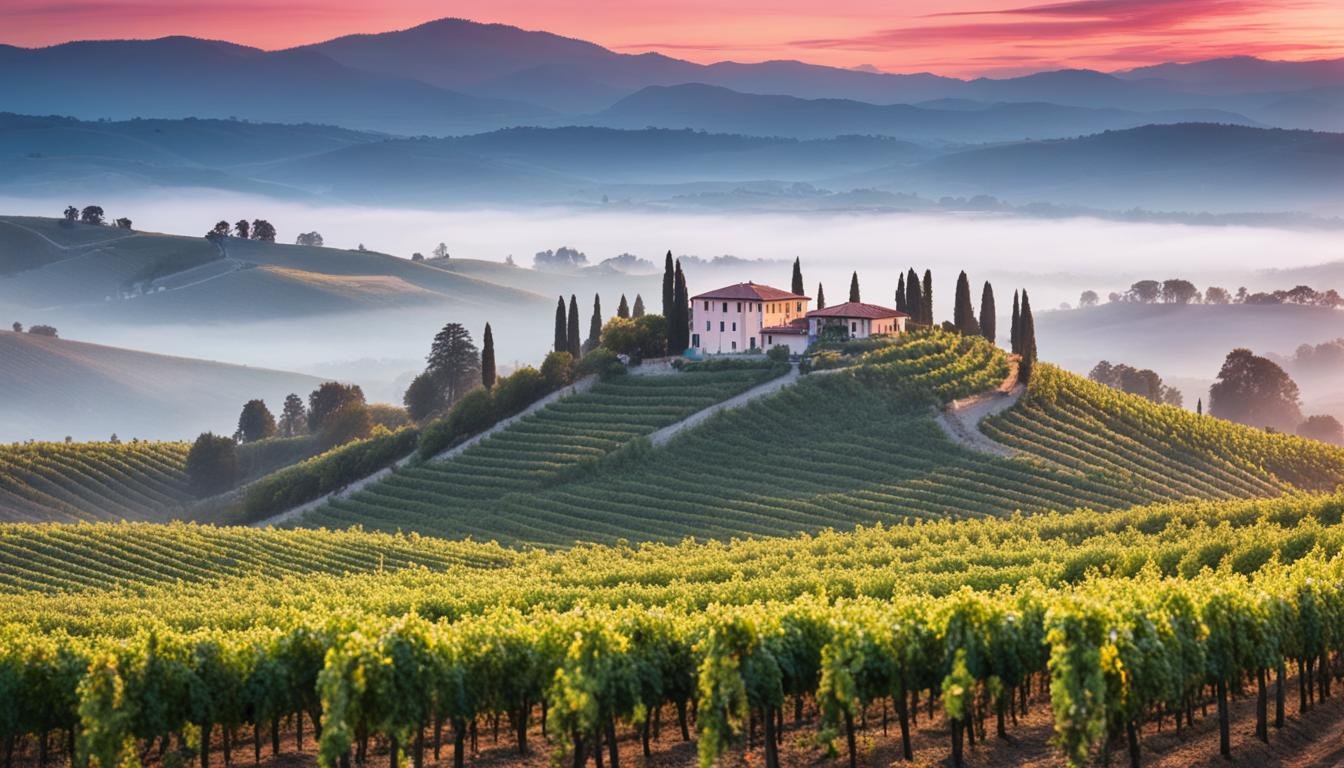This post may contain affiliate links. Please read my disclosure policy.
Nebbiolo: The Aristocrat of the Vineyard
Introduction
Nebbiolo, pronounced “Neb-ee-oh-low,”the pride of Piedmont’s vineyards, offers a drinking experience akin to enjoying a fine opera in a grand Italian theatre. This grape variety, essential to some of Italy’s most revered wines such as Barolo and Barbaresco, stands as a testament to the rich winemaking heritage of Italy. With its intricate palate and profound depth, Nebbiolo is a varietal that captivates connoisseurs and casual drinkers alike.
Primary Flavours
Delving into a glass of Nebbiolo is akin to stepping into an ancient library filled with leather-bound books. It greets you with a bouquet of rose petals, tart cherries, and hints of tar. There’s a certain nobility to its flavour profile, with subtle notes of truffle, tobacco, and dried herbs adding layers of sophistication. Nebbiolo is not just a wine; it’s a narrative of elegance and tradition.
Taste Profile
| Nebbiolo | Nebbiolo | Nebbiolo |
|---|---|---|
| Aspect | Rating out of 5 | Characteristic |
| Sweetness | 🍷 | Predominantly dry, whispering of ancient tales and terrains |
| Body | 🍷🍷🍷🍷 | Full-bodied, as majestic as a castle overlooking vineyards |
| Tannins | 🍷🍷🍷🍷🍷 | Robust and assertive, like a knight in shining armor |
| Acidity | 🍷🍷🍷🍷 | Elegantly high, a dance of grace and vitality |
| Alcohol by Volume | 🍷🍷🍷🍷 | Typically 13-14.5%, a harmonious balance of power and finesse |
Growing Regions
Nebbiolo, a varietal synonymous with the mist-covered hills of Piedmont in Northern Italy, particularly thrives in the Langhe region. Its unique ability to reflect its terroir means that the subtlest changes in microclimate and soil type can result in significantly different wine expressions. This adaptability has allowed Nebbiolo to spread its roots beyond Italy, finding new homes and expressions globally, each region adding its own narrative to the Nebbiolo story.
Origin
Steeped in the fog-laden landscapes of Piedmont, Nebbiolo’s history intertwines with the region’s winemaking traditions. The grape’s name, derived from the Italian ‘nebbia’ meaning fog, is a nod to the misty conditions prevalent during its harvest season. Revered for centuries, Nebbiolo has been at the heart of Piedmont’s winemaking, a constant through the region’s historical and cultural evolution.
Serving Temperature
To fully appreciate the wine’s elegant and complex nature, serving it at around 16-18°C (61-64°F) is ideal. This temperature range enhances its aromatic profile and depth of flavour, creating a harmonious balance that truly showcases its sophistication. At this optimal temperature, the subtle nuances are highlighted, revealing a spectrum of aromas and flavours that contribute to its esteemed reputation.
It’s about finding that sweet spot where every aspect, from the delicate floral notes to the rich, earthy undertones, is allowed to shine through, offering a refined and delightful tasting experience.
Glassware
Choosing the right glassware is essential in enhancing the wine’s drinking experience. A large wine glass with a spacious bowl is ideal, providing sufficient room for the wine to open up. This larger space is crucial for allowing the wine to interact with air, softening its pronounced tannins and revealing the intricate layers of its flavour and aroma profile.
The proper glass not only accentuates the wine’s inherent qualities but also transforms each sip into a more nuanced and enjoyable experience, making it an integral part of savouring this distinguished varietal.
Decanting
Deciding whether to decant depends largely on the wine’s maturity and structure. For the more tannic or mature varieties, decanting can be a transformative process. It allows the wine to oxygenate, softening the tannins and enhancing the overall bouquet and complexity.
This process can unveil hidden layers of aroma and taste, enriching the drinking experience. Conversely, the fresher, more vibrant versions are best enjoyed in their youthful state, allowing the drinker to experience the lively fruitiness and immediate charm that the wine offers.
Ageing
This wine is renowned for its remarkable capacity to age gracefully. As time passes, the bold fruitiness gradually gives way to a more sophisticated and intricate array of flavours, such as leather, tobacco, and dried fruits.
This evolution in the bottle is akin to a tapestry of flavours becoming more detailed and profound over time. Its ability to mature and develop over the years makes it particularly attractive to collectors and enthusiasts who relish observing the transformative power of time on a wine’s character and complexity.
Food Pairings
Pairing this distinguished wine with food is a delightful exploration of flavours. The high tannins and acidity of the wine make it a superb match for rich, fatty meats, where each bite becomes a gourmet experience. Imagine the wine alongside a succulent beef wellington or a tender, slow-cooked pork belly, where its robust character beautifully complements the meat’s richness.
Traditional Italian cuisine forms an exceptional partnership with this wine. Its depth and complexity find perfect counterparts in dishes like a hearty bolognese, a luxurious mushroom risotto, or a decadent truffle pasta. The wine enhances the rich, layered flavours of these Italian classics, creating an elevated dining experience.
For plant-based cuisine enthusiasts, the versatility of this wine is impressive. Earthy mushroom dishes, such as a porcini risotto or a wild mushroom ragout, are especially delightful. The wine’s depth resonates with the earthiness of the mushrooms, while its acidity provides a refreshing counterbalance to the richness of the dish. Rich, tomato-based sauces are also a splendid match, their vibrant acidity and savoury notes complementing the wine’s profile.
In essence, pairing this wine with food involves matching its bold character with equally robust dishes. Whether it’s a lavish meat dish, a flavour-packed plant-based creation, or a classic Italian pasta, this wine turns every meal into a gastronomic celebration.
The Nebbiolo Experience
In the grand tapestry of wine, Nebbiolo is the intricate thread that weaves a story of elegance, depth, and tradition. It’s a wine that demands attention and contemplation, inviting the drinker to explore its layered complexity. Each glass of Nebbiolo is a journey through history, a taste of the Piedmontese terroir, and an experience in the art of Italian winemaking.
Celebrated Wine Labels
| Nebbiolo | Nebbiolo | Nebbiolo |
|---|---|---|
| Country | Wine Label | Varietal Name & Style |
| Italy | Gaja | Barbaresco Elegance, Modern Expression |
| Italy | Giacomo Conterno | Time-Honoured Barolo, Age-worthy Elegance |
| Italy | Bruno Giacosa | Artisanal Mastery, Exceptional Quality |
| Italy | Vietti | Innovative Styles, Rich Diversity |
| Italy | Pio Cesare | Traditional Excellence, Consistent Quality |
| These celebrated producers have mastered the art of Nebbiolo, each showcasing unique interpretations that highlight the grape’s versatility and elegance. | These celebrated producers have mastered the art of Nebbiolo, each showcasing unique interpretations that highlight the grape’s versatility and elegance. | These celebrated producers have mastered the art of Nebbiolo, each showcasing unique interpretations that highlight the grape’s versatility and elegance. |
Conclusion
Nebbiolo is more than just a wine; it’s an expression of Italian winemaking at its finest. It’s about embracing the depth of flavours, the intricacy of aromas, and the legacy of a region steeped in viticultural heritage. So, when you next pour a glass of Nebbiolo, be prepared for an experience that’s as rich and multifaceted
What are some interesting facts about Nebbiolo?
• Nebbiolo is famous for producing Italy’s prestigious Barolo and Barbaresco wines.
• Native to the Piedmont region in northwestern Italy.
• Noted for its high tannins and acidity, essential for ageing.
• It typically presents flavours of cherry, rose, tar, and earthy notes.
Is Nebbiolo a red or white wine?
Nebbiolo is a red wine grape, renowned for producing complex, full-bodied red wines.
Where does the name Nebbiolo originate from?
The name “Nebbiolo” is believed to derive from the Italian word ‘nebbia’, meaning fog. This could reference the foggy conditions of the Piedmont region or the grape’s harvest time in late autumn when mists are common.
What wine is Nebbiolo similar to?
Nebbiolo is similar to Pinot Noir and Sangiovese in terms of its complexity and structure. These wines are known for their ability to develop nuanced flavours and aromas over time.
Is Nebbiolo known by any other names?
Nebbiolo is known by several local names in Piedmont, such as Spanna, Picutener, and Chiavennasca, reflecting the variety’s long history and regional significance in Italian viticulture.
User Review
( votes)Sip smarter, subscribe now!
Subscribe for gourmet tips, event updates, travel ideas, and a free e-book on Food Pairings. Start your journey to culinary and travel excellence!













